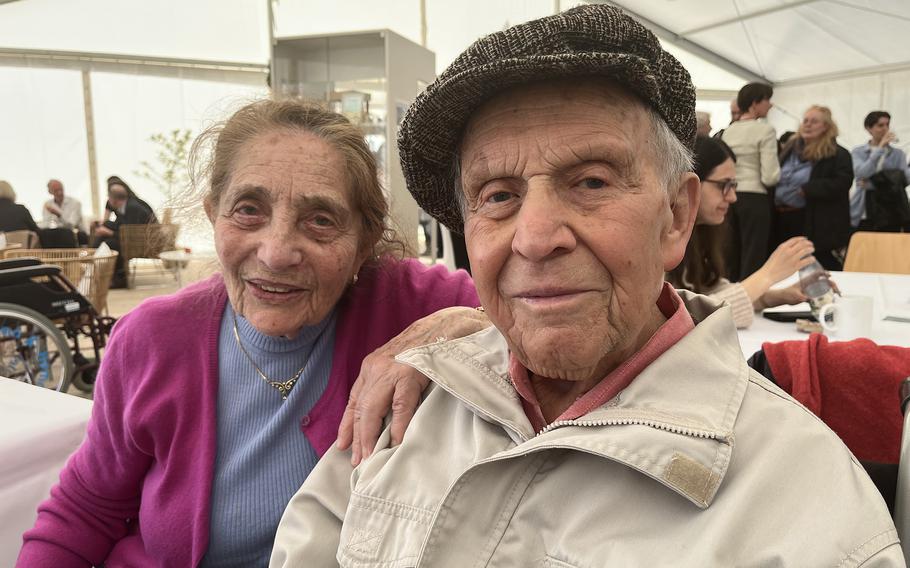
Shelomo Selinger, a 96-year-old Holocaust survivor, and his wife, Ruth, attend a memorial ceremony April 27, 2025, in Flossenbürg, Germany. Selinger was a prisoner at Flossenbürg concentration camp during World War II, and he returned for the 80th anniversary of the Allied liberation of the camp. (Matthew M. Burke/Stars and Stripes)
FLOSSENBÜRG, Germany — Shelomo Selinger spent a little more than a month at the Nazi concentration camp here during World War II before he was transferred north to one of its many subcamps.
But the 96-year-old Israeli-French sculptor, who attended a commemoration Sunday of the 80th anniversary of the Allied liberation of Flossenbürg, cannot shake the horrors of what he endured.
“There was torture; there was beatings; there was hunger; there was suffering until the end,” he said in an interview at the site, where he was joined by his wife, Ruth. “We were put in quarantine next to the crematorium. I remember that smell; I remember it all the time.”
Selinger survived nine concentration camps, including Flossenbürg, before he was freed at the end of the war.
The crowd of several hundred at Sunday’s event included six survivors of the camp in Bavaria, Selinger among them. The camp was liberated by the U.S. Army’s 90th Infantry Division on April 23, 1945.
A delegation of soldiers from U.S. Army Garrison Bavaria and the 7th Army Training Command was also in attendance.
Brig. Gen. Steven Carpenter, commander of the training unit, honored the victims and liberators while extolling the current relationship between the U.S. and Germany.
“It’s a very solemn occasion,” he said. “Moments like this, you can’t even imagine or put into words the atrocities that went on. You see the pictures and it’s almost like mind-boggling that we would treat other human beings in this way.”
Approximately 100,000 people from nearly every European country were imprisoned at Flossenbürg between 1938 and 1945, and the death toll there was 30,000. The area’s lucrative granite deposits drew the interest of the SS, which founded the camp.
The number of prisoners rose rapidly, from 1,500 in 1938 to around 15,000 at the end of February 1945.
Prominent detainees held there included Lutheran pastor Dietrich Bonhoeffer, Adm. Wilhelm Canaris and Maj. Gen. Hans Oster, all of whom were implicated in Operation Valkyrie, a failed plot to assassinate Adolf Hitler and overthrow his regime.
The three were hanged by the SS on April 9, 1945, as the Americans approached.
Sunday’s ceremony began in a tent under sunny skies at the site of the former camp, now a memorial and education center.
After the speeches, attendees moved to the area known as the “Valley of Death,” which includes the former crematorium, watchtower and a pyramid of human remains from thousands killed there.
Jewish and Christian religious leaders offered prayers during the memorial. Maj. Moshe Lans said commemorations and anniversary events play a vital role in teaching future generations.
Lans is the community chaplain for the Bavaria garrison and the only active-duty Jewish chaplain permanently assigned to the Army in Europe, he said.
“Younger soldiers today need to understand what their history is about,” he said. “You come to a place like Flossenbürg where you are confronted with that evil, and you have to understand what your nation expects of you is to do the right thing.”
After the ceremony, Selinger thanked the Americans in attendance by doffing his cap. He called for renewed vigilance against hatred in the contemporary world.
“Be careful; man is a creature that must be watched,” Selinger said in French through a translator. “He can be terrible and he can be wonderful. So make your choice if you’re one or the other.”